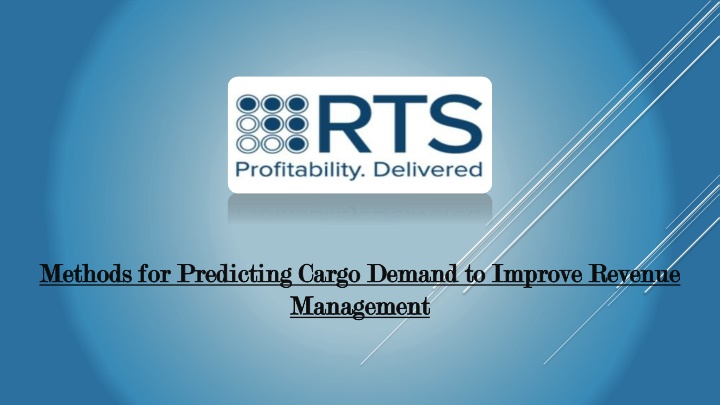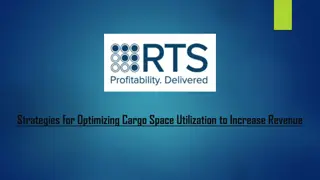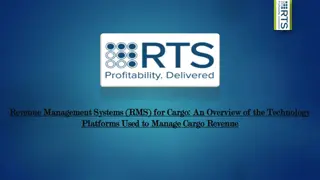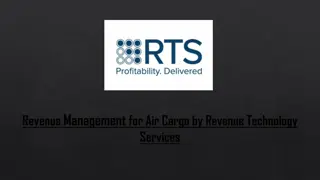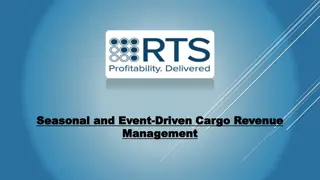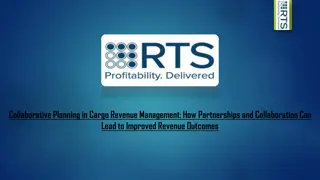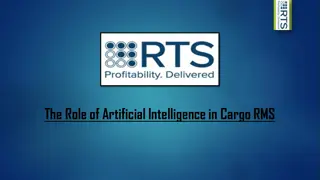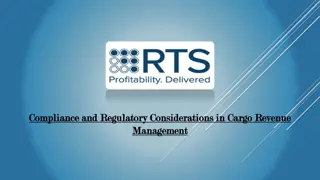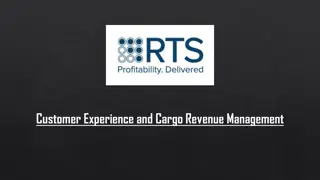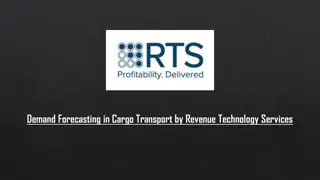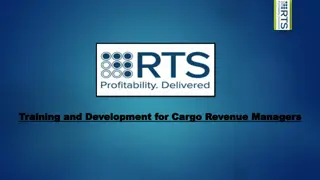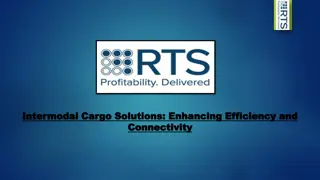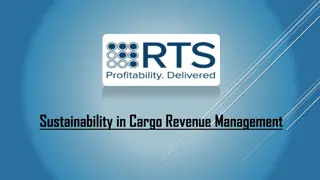Methods for Predicting Cargo Demand to Improve Revenue Management
In the competitive landscape of cargo transportation, accurately forecasting demand is crucial for optimizing revenue management. Predictive analytics play a pivotal role in aligning capacity with demand, ensuring efficient operations, and maximizing profitability. By leveraging advanced forecasting methods, cargo companies can navigate the complexities of the market, anticipate fluctuations, and make informed decisions. Here, we explore key methods for predicting cargo demand and their significance in enhancing cargo revenue management.n
Download Presentation

Please find below an Image/Link to download the presentation.
The content on the website is provided AS IS for your information and personal use only. It may not be sold, licensed, or shared on other websites without obtaining consent from the author.If you encounter any issues during the download, it is possible that the publisher has removed the file from their server.
You are allowed to download the files provided on this website for personal or commercial use, subject to the condition that they are used lawfully. All files are the property of their respective owners.
The content on the website is provided AS IS for your information and personal use only. It may not be sold, licensed, or shared on other websites without obtaining consent from the author.
E N D
Presentation Transcript
Methods for Predicting Cargo Demand to Improve Revenue Methods for Predicting Cargo Demand to Improve Revenue Management Management
In the competitive landscape of cargo transportation, accurately forecasting demand is crucial for optimizing revenue management. Predictive analytics play a pivotal role in aligning capacity with demand, ensuring efficient operations, and maximizing profitability. By leveraging advanced forecasting methods, cargo companies can navigate the complexities of the market, anticipate fluctuations, and make informed decisions. Here, we explore key methods for predicting cargo demand and their significance in enhancing cargo revenue management.
Historical Data Analysis Historical Data Analysis One of the most foundational methods for forecasting demand in cargo transportation is historical data analysis. By examining past trends, shipment volumes, and seasonal variations, companies can identify patterns and predict future demand. Historical data provides a benchmark, helping to forecast not only regular demand cycles but also anomalies caused by external factors. This method, while traditional, forms the bedrock of more sophisticated forecasting models. Time Series Analysis Time Series Analysis Time series analysis delves deeper into historical data, focusing on identifying and interpreting trends over time. Techniques such as moving averages, exponential smoothing, and ARIMA (Auto-Regressive Integrated Moving Average) models are commonly used. These methods help in smoothing out short-term fluctuations and highlighting longer-term trends. By doing so, cargo companies can develop more accurate demand forecasts, which are crucial for strategic planning and capacity management. Machine Learning Algorithms Machine Learning Algorithms The advent of machine learning has revolutionized demand forecasting in cargo transportation. Machine learning algorithms, including regression models, neural networks, and decision trees, can analyze vast amounts of data and identify complex patterns that traditional methods might miss. These algorithms can incorporate a wide range of variables, such as economic indicators, weather conditions, and market trends, to enhance the accuracy of demand predictions. Machine learning models continuously learn and adapt, providing dynamic forecasts that improve over time.
Simulation Models Simulation Models Simulation models are particularly useful in scenarios with high uncertainty or when historical data is limited. By creating virtual models of the cargo transportation system, companies can simulate various demand scenarios and assess their impact on operations and revenue. Monte Carlo simulations, for example, allow companies to evaluate a range of possible outcomes and develop strategies to mitigate risks. This method provides a flexible and robust approach to forecasting, especially in volatile markets. Integrating External Data Integrating External Data Incorporating external data sources, such as economic forecasts, geopolitical developments, and industry trends, can significantly enhance the accuracy of demand forecasts. By integrating macroeconomic indicators, companies can anticipate shifts in demand driven by broader market forces. For instance, changes in trade policies, fuel prices, or global economic conditions can have profound impacts on cargo demand. By staying attuned to these external factors, cargo companies can make proactive adjustments to their cargo revenue management strategies. Collaborative Forecasting Collaborative Forecasting Collaborative forecasting involves sharing information and collaborating with key stakeholders, such as suppliers, customers, and logistics partners. This approach ensures a more holistic view of demand, as it incorporates insights from various points along the supply chain. Collaborative forecasting fosters better communication, reduces uncertainties, and aligns expectations across the board, leading to more accurate demand predictions and improved revenue management.
Conclusion Conclusion Effective demand forecasting is a cornerstone of successful cargo revenue management. By leveraging a combination of historical data analysis, time series analysis, machine learning algorithms, simulation models, and external data integration, cargo companies can achieve more accurate and reliable demand forecasts. These advanced forecasting methods enable companies to optimize capacity, reduce operational inefficiencies, and enhance profitability. In an industry characterized by rapid changes and uncertainties, robust demand forecasting capabilities are essential for sustaining competitive advantage and driving long-term success.
THANK YOU THANK YOU
